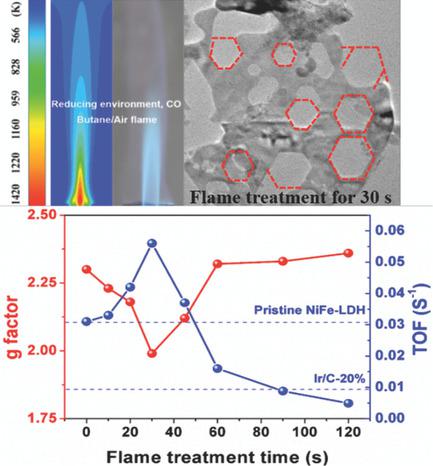当前位置:
X-MOL 学术
›
Small Methods
›
论文详情
Our official English website, www.x-mol.net, welcomes your
feedback! (Note: you will need to create a separate account there.)
Flame‐Engraved Nickel–Iron Layered Double Hydroxide Nanosheets for Boosting Oxygen Evolution Reactivity
Small Methods ( IF 10.7 ) Pub Date : 2018-05-17 , DOI: 10.1002/smtd.201800083 Daojin Zhou 1 , Xuya Xiong 1 , Zhao Cai 1 , Nana Han 1 , Yin Jia 1, 2 , Qixian Xie 1 , Xinxuan Duan 1 , Tianhui Xie 1 , Xiaolin Zheng 3 , Xiaoming Sun 1, 2 , Xue Duan 1
Small Methods ( IF 10.7 ) Pub Date : 2018-05-17 , DOI: 10.1002/smtd.201800083 Daojin Zhou 1 , Xuya Xiong 1 , Zhao Cai 1 , Nana Han 1 , Yin Jia 1, 2 , Qixian Xie 1 , Xinxuan Duan 1 , Tianhui Xie 1 , Xiaolin Zheng 3 , Xiaoming Sun 1, 2 , Xue Duan 1
Affiliation

|
Introducing oxygen vacancies to metal oxide materials would improve their catalytic activity but usually needs reductive reagents (e.g., H2) and high temperatures (e.g., >600 °C), which is unsafe, complex, and time consuming. Herein, a fast (30 s) and facile (operated at ambient conditions) flame‐engraved method is used to introduce abundant oxygen vacancies and well‐defined hexagonal cavities with (110) edges to nickel–iron layered double hydroxides (NiFe‐LDH). Abundant oxygen vacancies, lower coordination numbers, and electron‐rich structures of Ni and Fe sites emerge in the flame‐engraved NiFe‐LDH array electrode, leading to its onset potential as low as 1.40 V (vs reversible hydrogen electrode) for oxygen evolution reaction. This highlights the importance and convenience of flame‐engraving method in preparing metal hydroxides with abundant oxygen vacancies, which can be used as efficient electrochemical catalysts.
中文翻译:

火焰雕刻镍-铁层状双氢氧化物纳米片,用于增强氧气释放反应性
向金属氧化物材料中引入氧空位会提高其催化活性,但通常需要还原剂(例如H 2)和高温(例如> 600°C),这是不安全,复杂且耗时的。在此,一种快速(30 s)且简便易行(在环境条件下运行)的火焰刻划方法将大量的氧空位和边缘清晰的六角形腔体(110个)边缘引入到镍铁层状双氢氧化物(NiFe-LDH)中。刻有火焰的NiFe-LDH阵列电极中会出现大量的氧空位,较低的配位数以及Ni和Fe位的富电子结构,导致其发生氧放出反应的起始电位低至1.40 V(相对于可逆氢电极) 。这突出了火焰雕刻法在制备具有大量氧空位的金属氢氧化物中的重要性和便利性,这些金属氢氧化物可用作有效的电化学催化剂。
更新日期:2018-05-17
中文翻译:

火焰雕刻镍-铁层状双氢氧化物纳米片,用于增强氧气释放反应性
向金属氧化物材料中引入氧空位会提高其催化活性,但通常需要还原剂(例如H 2)和高温(例如> 600°C),这是不安全,复杂且耗时的。在此,一种快速(30 s)且简便易行(在环境条件下运行)的火焰刻划方法将大量的氧空位和边缘清晰的六角形腔体(110个)边缘引入到镍铁层状双氢氧化物(NiFe-LDH)中。刻有火焰的NiFe-LDH阵列电极中会出现大量的氧空位,较低的配位数以及Ni和Fe位的富电子结构,导致其发生氧放出反应的起始电位低至1.40 V(相对于可逆氢电极) 。这突出了火焰雕刻法在制备具有大量氧空位的金属氢氧化物中的重要性和便利性,这些金属氢氧化物可用作有效的电化学催化剂。









































 京公网安备 11010802027423号
京公网安备 11010802027423号